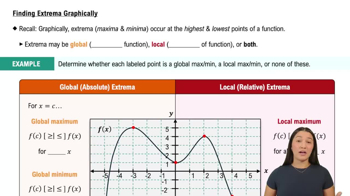Table of contents
- 0. Functions7h 52m
- Introduction to Functions16m
- Piecewise Functions10m
- Properties of Functions9m
- Common Functions1h 8m
- Transformations5m
- Combining Functions27m
- Exponent rules32m
- Exponential Functions28m
- Logarithmic Functions24m
- Properties of Logarithms34m
- Exponential & Logarithmic Equations35m
- Introduction to Trigonometric Functions38m
- Graphs of Trigonometric Functions44m
- Trigonometric Identities47m
- Inverse Trigonometric Functions48m
- 1. Limits and Continuity2h 2m
- 2. Intro to Derivatives1h 33m
- 3. Techniques of Differentiation3h 18m
- 4. Applications of Derivatives2h 38m
- 5. Graphical Applications of Derivatives6h 2m
- 6. Derivatives of Inverse, Exponential, & Logarithmic Functions2h 37m
- 7. Antiderivatives & Indefinite Integrals1h 26m
- 8. Definite Integrals3h 25m
5. Graphical Applications of Derivatives
Intro to Extrema
Problem 4.1.27
Textbook Question
Locating critical points Find the critical points of the following functions. Assume a is a nonzero constant.
ƒ(x) = 3x³ + 3x² / 2 - 2x
 Verified step by step guidance
Verified step by step guidance1
Start by finding the derivative of the function ƒ(x) = 3x³ + (3/2)x² - 2x. This will help identify where the function's slope is zero or undefined.
Set the derivative equal to zero to find the critical points. This means solving the equation f'(x) = 0.
Factor the derivative if possible to simplify the equation and make it easier to solve for x.
Solve for the values of x that satisfy the equation from the previous step. These x-values are the critical points.
Verify if the critical points are indeed critical by checking if the derivative is undefined at any of these points.
Was this helpful?

 5:58m
5:58mWatch next
Master Finding Extrema Graphically with a bite sized video explanation from Callie
Start learning





